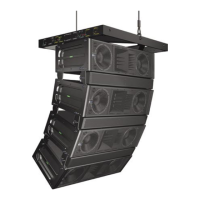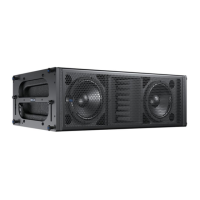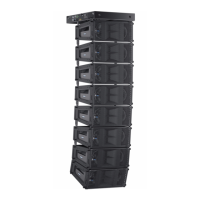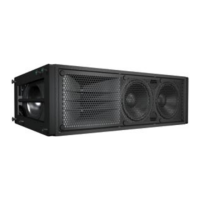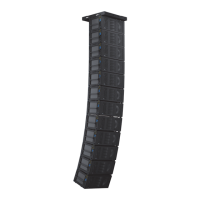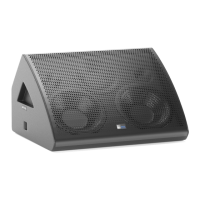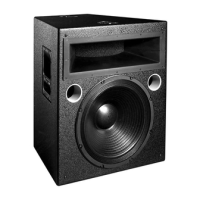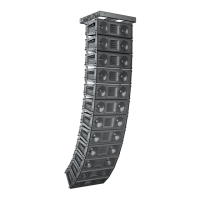2
INTRODUCTION
Figure i.3: A combined MILO/M3D-Sub array
NOTE: MILO can also be used in
combination with other Meyer Sound
subwoofers — for example, the 650-P.
MILO’s QuickFly rigging employs rugged, reliable and
user-friendly components that remain captive both in
use and in transit. Custom front and rear AlignaLinks at
the cabinet corners couple the units for either ying or
stacking, and allow nine positions from 0° to 5° of cabinet
splay (0°, 0.5°, 1°, 1.5°, 2°, 2.5°, 3°, 4° and 5°). Because
rigging connections are rigid, the array tilt is easy to adjust
– often eliminating the need for a pullback strap in own
congurations. If circumstances dictate an acute array
curve, then a PBF-MILO pull back frame can be attached to
the lowest cabinet.
NOTE: Rigging accessories for MILO are
illustrated in Meyer Sounds MG-3D/M
Assembly Guide.
INTEGRATED AMPLIFIER AND PROCESSING
As a self-powered loudspeaker, MILO incorporates a very
high power, four-channel, class AB/H power amplier and
sophisticated control circuitry — all housed within the
cabinet — dramatically simplifying setup and installation.
Power distribution is supplied to the array, line-level signal
connected, and that’s it – you’re focusing on design
implementation instead of installation.
MILO’s on-board amplier delivers a prodigious 3935 watts
total burst power. TruPower™ limiting (see Chapter 2 for
more information) extends the life of MILO’s drivers under
severe non-linear circumstances at very high levels, and
keeps long-term power compression to less than 1 dB
(versus the typical 3 - 6 dB for conventional systems).
The modular, eld-replaceable amplier/processing
package also incorporates Meyer Sound’s Intelligent
AC power supply, which automatically adjusts for any
line voltage worldwide and provides both soft turn-on
and transient protection. MILO is tted standard with
Meyer Sound’s exclusive RMS™ interface, giving you the
capability to monitor and troubleshoot an entire RMS-
equipped Meyer Sound system remotely from your PC
notebook or desktop system.
NOTE: In order to use RMS, you will need
Meyer Sound’s optional RMS software and a
PC running Windows® 98/NT 4.0/2000/XP or higher.
The optional RMS host card is also required, and
is available as a full-size (standard) PCI or Type II
PCMCIA card, depending on your PC’s hardware.
